Alright folks, Ovi Tanchangya here, and I must confess: knowing how to pack a motorcycle for camping is an art in itself.
I mean, nothing beats the smell of campfire smoke and camp foods, right?
I’ve wandered countless trails, and let me tell you, packing your motorcycle the right way makes a world of difference.
By the end, you’ll be itching to hit the road, with the wind in your hair and the knowledge to camp like a boss. Let’s throttle up!
What to Consider Before Packing for Motorcycle Camping
Before we get into what to pack, it’s crucial to discuss some factors that will influence what goes into your motorcycle saddlebags. Your motorcycle’s load capacity, the weather forecast, and the duration of your trip are all vital factors to consider when packing for your adventure.
Motorcycle’s Load Capacity
Understanding your motorcycle’s load capacity is the first step to safe and efficient packing. Just like you wouldn’t overload a backpack for a hike, you shouldn’t overload your bike either. Every motorcycle has a load limit, which includes the rider, passenger (if you have one), and gear. Overloading can significantly impact your bike’s handling and performance, making your ride unsafe. So, be sure to check your motorcycle’s manual or consult the manufacturer to learn about its load capacity.
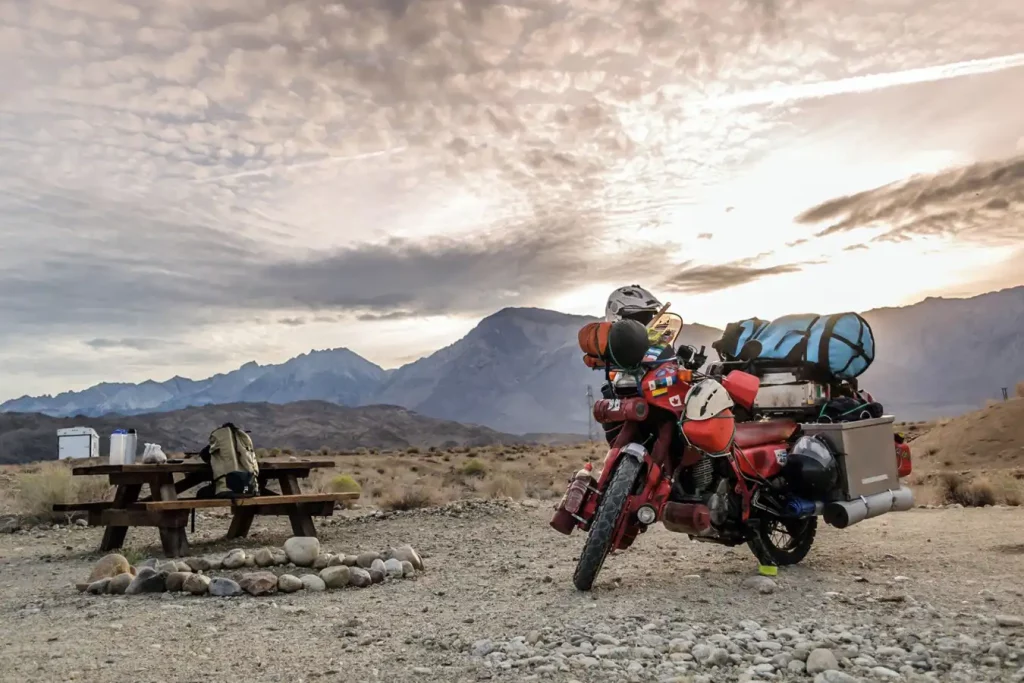
Weather Conditions
Mother Nature, while beautiful, can also be unpredictable. Keeping a keen eye on the weather forecast for your travel dates and destination is a smart move. The last thing you want is to be stuck in a rainstorm without waterproof gear or in a heatwave without adequate water. Packing gear appropriate to the weather conditions will ensure you remain comfortable throughout your trip.
Duration of the Trip
The length of your camping trip significantly influences what you’ll pack. A weekend getaway requires much less gear than a week-long expedition. Carefully plan your meals, clothes, and other essentials according to the duration of your trip. Remember, packing efficiently doesn’t mean leaving behind essential items to save space. It’s all about being resourceful and choosing items that are compact, lightweight, and multi-functional.
Essential Items to Pack for Motorcycle Camping
Now that we’ve established what factors to consider before packing, let’s dive into the heart of our topic – what to pack. It’s tempting to throw everything but the kitchen sink into your bag, but remember, we’re packing for a motorcycle camping trip – not a luxury cruise. I’ll walk you through a list of essential items to pack, broken down into three categories: camping gear, personal items, and safety and maintenance tools.
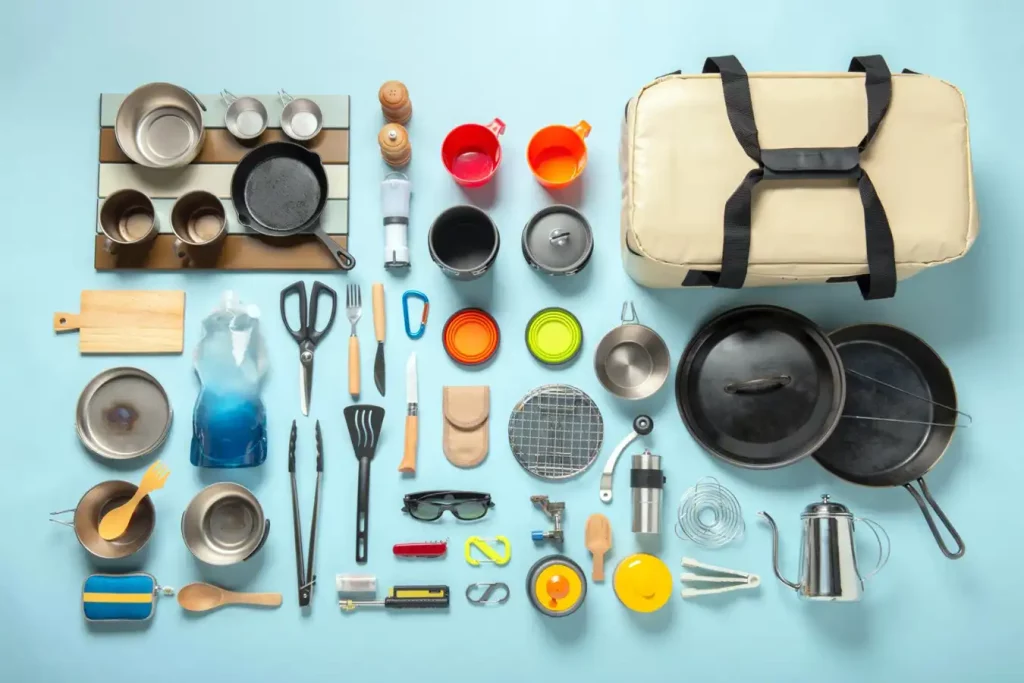
Camping Gear You Can’t Go Without
When it comes to camping gear, there are a few items you simply can’t compromise on. They form the backbone of your camping experience and contribute significantly to your comfort and safety.
- Tent: Compact and lightweight is the way to go. Look for a tent that’s easy to set up and offers good resistance to wind and rain.
- Sleeping Bag: Opt for a temperature-rated sleeping bag suitable for the weather conditions you’ll encounter.
- Cooking Gear: A portable stove, fuel, a small pot or pan, and basic utensils should suffice for most trips. Don’t forget a compact spice kit!
- Water Purification System: Whether it’s a filter, purification tablets, or a UV pen, having a means to purify water is critical.
- Light Source: A good headlamp will keep your hands free for other tasks in the dark.
Personal Items
Personal items largely depend on personal preference, but here are some general categories and suggestions:
- Clothing: Pack layers and remember the golden rule – avoid cotton! Opt for quick-dry materials.
- Food and Water: Plan your meals, bring compact food items, and always carry more water than you think you’ll need.
- Toiletries: Keep it simple with travel-sized items. Biodegradable soap is a great option for camping.
- First Aid Kit: Include essentials such as band-aids, antiseptic wipes, tweezers, insect repellent and any necessary prescription medication.
Safety and Maintenance Tools
Motorcycle camping means being your mechanic. It’s vital to bring along a few select tools and items to help you navigate any minor breakdowns or perform routine maintenance:
- Basic Tool Kit: This should include items like a multi-tool, duct tape, zip ties, an adjustable wrench, and a tire repair kit.
- Portable Air Compressor: This compact tool can be a lifesaver when dealing with a flat tire in the middle of nowhere.
- Jump Starter or Portable Charger: Ideal for giving your bike a boost if your battery dies or charging your phone in case of emergencies.
Remember, the goal is to be self-reliant and comfortable during your trip. But always leave some room for spontaneity and adventure because that’s what motorcycle camping is all about!
Learn more: How to Make Your Backpack Lighter
Step-by-Step: How to Pack a Motorcycle for Camping
Let’s get down to the nitty-gritty. I’ll walk you through a simple, step-by-step guide on how to efficiently pack your motorcycle for your next camping adventure. These steps have been gleaned from my own experiences and are designed to help you maximize your bike’s space while ensuring a balanced and secure load.
Step 1: Starting with the Heavy Items
You should always start by packing your heaviest items first. These typically include items such as your tools, water, and cooking gear. Ideally, they should be placed low and towards the center of the bike. This will help to keep the bike’s center of gravity low, making it easier to handle.
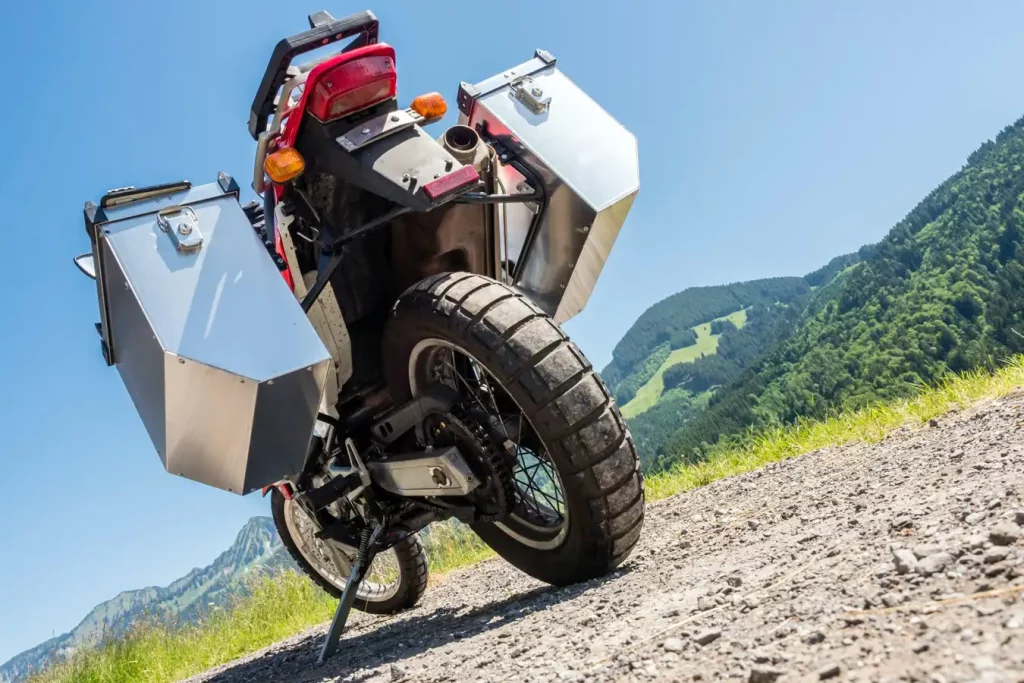
Step 2: Distributing the Weight
A well-balanced motorcycle is crucial, especially when traversing through winding mountain roads or bumpy trails. Try to distribute the weight of your items evenly across both sides of your bike. Don’t forget to factor in the weight of the fuel tank which is usually on one side of the bike.
Step 3: Packing the Camping Gear
After the heavy items are securely packed, move on to the camping gear. Your tent, sleeping bag, and clothes can be packed in waterproof compression sacks. These are excellent for saving space and keeping your items dry. They can be strapped onto the top of your panniers or across the back seat of the motorcycle.
Step 4: Securing the Load
Ensuring that your load is secure is of paramount importance. Use bungee cords, cargo nets, or motorcycle-specific straps to secure your gear. Check that everything is snug and doesn’t move. There should be no loose ends that can flap in the wind or get caught in the wheel.
Step 5: Checking the Load
Once everything is packed and secured, do a final check. Sit on your bike and see how it feels. Check your mirrors to ensure visibility is not obstructed. Move the bike around a bit to see how the added weight affects handling.
Tips for a Successful Motorcycle Camping Trip
Beyond packing, there are additional elements that can contribute to a successful motorcycle camping trip. Good route planning can help you locate scenic trails and perfect camp spots. Leave early in the day to make the most of daylight. Practice setting up your tent at home to save time at the campsite. And finally, always leave your campsite cleaner than you found it.
By following this guide, you’re already on your way to a memorable motorcycle camping trip. Pack smart, ride safe, and enjoy the freedom that comes with the open road and the great outdoors.
Also learn: How to Loosen Backpack Straps
Safety Precautions for Motorcycle Camping
While the thrill of the open road and the beauty of the great outdoors are among the key attractions of motorcycle camping, it’s paramount to consider safety. A successful trip not only relies on the right gear and proper packing but also on the proactive measures taken to ensure you’re safe throughout your journey.
Safety Measures while Packing and Riding
Safety starts with packing. We’ve already discussed securing your load and distributing weight evenly, but there’s more to safety than just these aspects. Consider packing reflective gear for visibility, especially when riding in low light conditions. And never forget your helmet and hand gloves —it’s your first line of defense on the road.
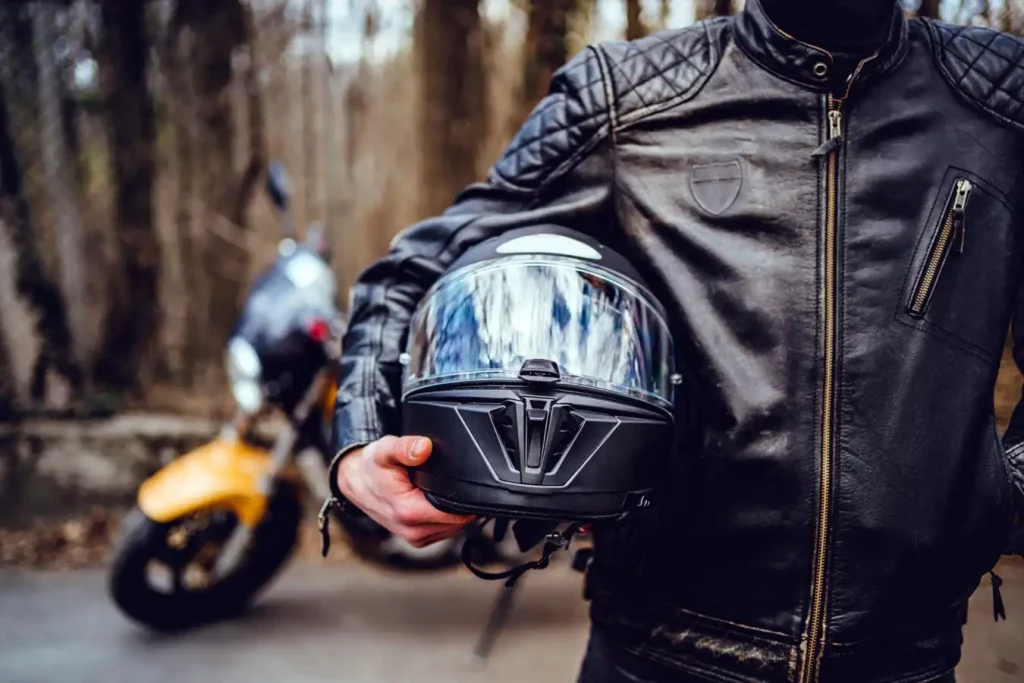
On the road, practice defensive riding. Be aware of your surroundings, anticipate potential hazards, and maintain safe distances from other vehicles. Try to ride in a group if possible, as there’s safety in numbers.
It’s also essential to stay hydrated and take regular breaks to combat fatigue. Riding while tired can significantly impair your reflexes and judgment, leading to unnecessary accidents. Remember, it’s not a race—take your time and enjoy the ride.
Motorcycle Maintenance for Long Journeys
Before you embark on your camping trip, conduct a thorough inspection of your motorcycle. Check the tire pressure and tread, brake pads, oil and coolant levels, and make sure your lights and indicators are working correctly.
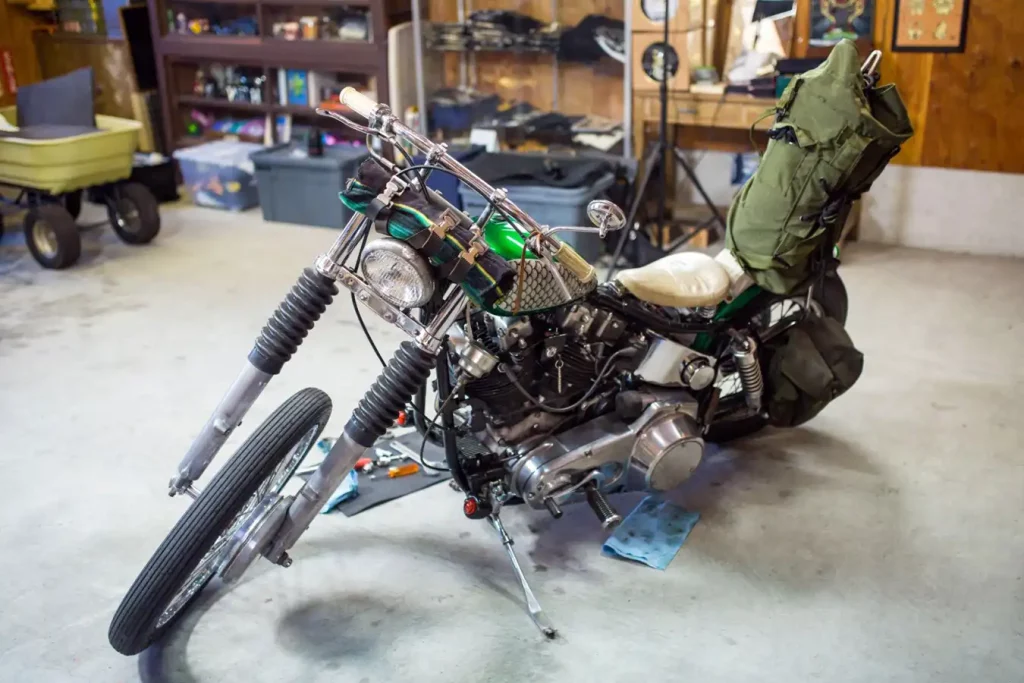
Don’t forget to inspect your chain or drive belt for wear and ensure it’s properly lubricated. If you’re planning on a particularly long journey, consider getting your bike professionally serviced before leaving. The peace of mind knowing that your bike is in top condition is priceless.
Handling Emergencies and Breakdowns
Unfortunately, despite our best efforts, emergencies and breakdowns can happen. It’s crucial to have a plan in place.
For medical emergencies, always carry a basic first-aid kit and learn how to use it. Keep emergency contact numbers handy, and make sure someone knows your travel plans and expected return date.
If you experience a breakdown, it pays to have basic motorcycle repair knowledge. Carry a repair manual for your bike, along with a toolkit with essential items like an adjustable wrench, tire repair kit, and jumper cables.
Motorcycle camping is a fantastic adventure, but always remember, safety comes first. By following these safety precautions, you’ll be well-prepared to handle any situation, and you can focus on enjoying your trip.
Returning Home: Post-Camping Wrap-up
Just as the excitement of heading out on a motorcycle camping trip gets your heart racing, the return journey, with all its reflections and fulfillment, brings a sense of closure. But as any seasoned camper knows, the adventure isn’t truly over until you’ve taken care of some post-camping tasks.
Packing Up Your Campsite
One of the most fundamental principles of camping is to “leave no trace.” That means when you pack up to leave, your campsite should look as pristine as when you arrived. Dispose of your trash responsibly, extinguish your campfire thoroughly, and ensure you’ve not left any belongings behind.
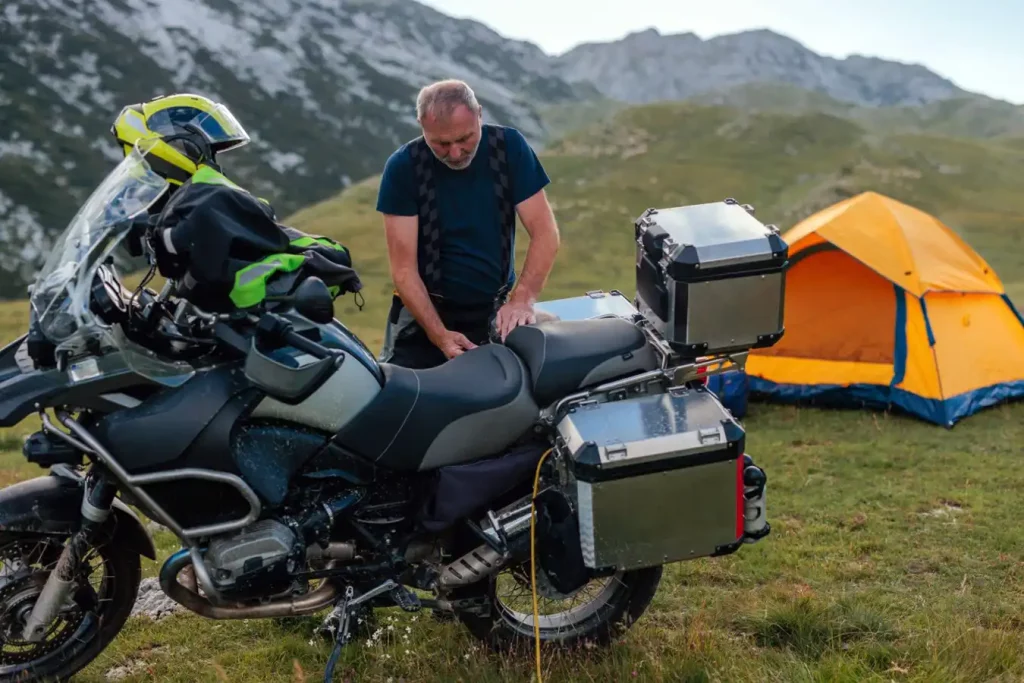
When packing your gear for the ride home, remember the same principles that you used when packing for the journey out. Heaviest items go low and toward the center of the bike, distribute weight evenly, and secure your load. With these steps, you’re set for a safe journey home.
Motorcycle Post-Trip Maintenance
Once you’re back, it’s time to care for your motorcycle and gear. Your bike has served you well during your trip, and it’s essential to clean and inspect it post-trip. Look for any damages that may have occurred on the trip, check your tire pressure, oil level, and top up if necessary. Cleaning off any accumulated dirt or mud will prevent rust and keep your bike in good condition for your next adventure.
Your camping gear also needs attention. Clean and dry everything thoroughly before storing to prevent mold and mildew. Check for any damages and repair or replace items if needed. Proper care will prolong the life of your gear and have you ready for your next camping trip.
FAQs about Pack a Motorcycle for Camping
What should I pack for motorcycle camping?
You should pack essentials like a tent, sleeping bag, cooking equipment, clothing suitable for the weather, a first-aid kit, and basic motorcycle maintenance tools.
How do you carry a tent on a motorcycle?
A tent can be carried on a motorcycle using a durable waterproof bag, secured to the back seat or a rear rack with strong bungee cords or straps.
How do you carry camping equipment on a motorcycle?
Camping equipment can be carried using saddlebags, tank bags, and tail bags, or strapped securely to the motorcycle using cords. Always ensure the load is evenly balanced.
How do you camp with a motorcycle?
Camping with a motorcycle involves careful planning, carrying multipurpose items to save space, and packing gear securely and balanced on the motorcycle. Always remember to prioritize safety.
Where should you sleep when traveling on a motorcycle?
When traveling on a motorcycle, you can sleep in camping sites, national parks, or other designated camping areas. Always check local regulations and permissions.
What do you wear on a motorcycle at night?
Final Thoughts about Pack Motorcycle for Camping
Packing a motorcycle for camping is more than just fitting your items onto your bike. It involves careful planning, consideration for your bike’s load capacity, and thoughtful selection of what to bring. It’s a balance of ensuring you’re prepared for your camping adventure while maintaining the integrity and safety of your motorcycle.
So, what’s next? With the knowledge you’ve gained, it’s time to plan your trip, pack up your bike, and hit the open road. Enjoy the unique joy of motorcycle camping and the sense of freedom it offers.
And when you return, remember that your bike and gear will need some love and attention, too. With careful post-trip maintenance, you’ll be ready to embark on your next journey whenever the spirit of adventure calls.
So, are you ready to pack your motorcycle and set out on your camping adventure?


